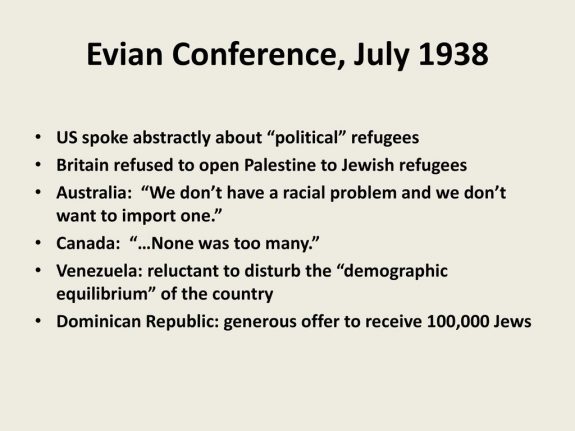The Évian Conference

By Dr George Venturini
The Évian Conference
In 1930, with the Great Depression severely affecting Australia’s workforce, the Scullin Government (1929 – 1932) tightened up entry requirements for ‘aliens’, demanding that only those immigrants who had £500 landing money, or who were dependent relatives of aliens already living in Australia, would be permitted to enter the country.
Following the election of Adolf Hitler in Germany, a group of concerned Jewish spokesmen, led by Rabbis F. L. Cohen and Israel Brodie, travelled to Canberra and personally lobbied the Minister for the Interior to admit a limited number of skilled German-Jewish refugees. But it was to no avail. Two years later, and following Hitler’s promulgation of the notorious Nuremberg Laws (German: Nürnberger Gesetze) which were purposely anti-semitic and racial laws, and had been enacted by a submitted Reichstag on 15 September 1935, prominent Sydney leader Sir Samuel Cohen presided over the formation of the German Jewish Relief Fund, which tried to emulate similar initiatives in Britain by raising funds to assist young German Jews to escape to Palestine or other ‘safe havens’.
Simultaneously, Cohen, Brodie and Brigadier Harold Cohen, among others, continued to press Government members for an easing of immigration restrictions. The successor Lyons Government (1932-1939) compromised by reducing landing money to £50 for those migrants guaranteed by family or friends. It also encouraged the formation of the Australian Jewish Welfare Society, A.J.W.S. to coordinate migration processes. Australia House in London reportedly received 120 inquiries a day from would-be immigrants in March 1938, while the A.J.W.S. received 1200 pleas for assistance in the week following the German invasion of Austria, the so-called Anschluss Österreichs, on 12 March 1938.
The A.J.W.S. was sensitive to Government and public sentiment and concerned that its actions could have been affected by the presumption that any marked increase in migrant numbers would merely jeopardise existing, and already tenuous, concessions. As a result it could accept only a fraction of the 70,000 applications for help it had received.
In July 1938 Australia followed Britain’s lead by agreeing to send representatives to Évian-les-Bains, France where a world summit was to seek solutions to the refugee problem. Named officially the ‘Intergovernmental Committee on Refugees’, the conference – originally the initiative of President Franklin D. Roosevelt and held on 6 to 15 July – brought together delegates from 32 nations.
The results of the conference were disappointing; it was clear from the outset that none of the participating countries was willing to modify its existing migration restrictions.
The Australian delegation was headed by Lieut. Col. T. W. White, Federal Minister for Trade and Customs. He bluntly informed the participants that Australia was committed to its policy of British migration, and declared that ‘as we have no real racial problem, we are not desirous of importing one by encouraging any scheme of large-scale foreign migration.’
Clearly White had not heard of the ‘Day of Mourning’, a protest held by Indigenous People on 26 January 1938, the 150th anniversary of British invasion of Australia. It was declared to be a protest of 150 years of the seizure of the land and of criminal treatment of the original population. It purposefully coincided with the Australia Day celebrations held by the non-Indigenous population on the same day. The protest became a tradition, and annual ‘Days of Mourning’ have been held ever since.
White was voicing a widespread national sentiment. According to a public survey conducted at this time, only 17 per cent of the Australian population was in favour of large-scale immigration of Jews. There was intense disquiet about the reluctance of Jews ‘to integrate’ – whatever that may ever mean – or the possibility that refugees would ‘swamp’ some professions or take away jobs from ‘Australians’. Already rigid quotas had been imposed on the number of refugee practitioners able to enter the medical profession in Australia.
At the Évian conference, the United States itself – represented not by Roosevelt or even an elected official but by a friend of the President called Myron C. Taylor – refused to increase the annual admission quota of 27,370 from Germany and Austria even before the meeting began. Edward Turnour, 6th Earl Winterton, Lord Winterton, the leader of the British delegation, clearly outlined his country’s position: “The United Kingdom is not a country of immigration.”
By 1938 more than half a million refugees would be on the move across Europe, fleeing the Nazis, who had rendered first 900,000 German Jews stateless under the Nuremberg Laws, then 200,000 Austrian Jews following the invasion in 1938.
After Kristallnacht (literally “Crystal night”) or ‘The night of broken glass’, between 9 and 10 November 1938, which was an anti-Jewish pogrom in Nazi Germany – then including Austria and Sudetenland – and in slow response to increasingly urgent calls to increase its refugee intake, the Australian Government announced that it would accept 15,000 refugees – 12,000 of them Jews – over the subsequent three years.
This apparent ‘liberalisation’ of policy was, in fact, nothing of the kind. Australia was effectively already accepting 5,100 refugees per annum – before December 1938 – and the new quota actually reduced the proposed intake. The trick was intended to advertise the Government as compassionate, liberal and ‘humanitarian’; in reality, the new policy cynically used the opportunity to curtail whatever trend there had previously been towards a growth in refugee admissions. As it was, a mere fraction of the first annual quota had reached Australia before the second world war broke out. In fact, only some 7,000 Jews settled in Australia between 1933 and 1939. (IRIN | ‘Look back and learn: The Evian Conference, 1938’; see also: Evian Conference – ThoughtCo; The Evian Conference | The Holocaust Encyclopedia).
Once war against Germany by Britain and its allies had been declared in September 1939, immigration effectively ceased, although a small number of refugees did manage to reach Australia through the Orient in the early years of conflict. As former citizens of enemy states, quite a number of them were promptly – albeit temporarily – interned as ‘enemy aliens’.
Continued Wednesday – The Kimberley Plan
Previous instalment – Adjunct imperialist clowns (part 2)
 Dr. Venturino Giorgio Venturini devoted some seventy years to study, practice, teach, write and administer law at different places in four continents. He may be reached at George.venturini@bigpond.com.au.
Dr. Venturino Giorgio Venturini devoted some seventy years to study, practice, teach, write and administer law at different places in four continents. He may be reached at George.venturini@bigpond.com.au.
Like what we do at The AIMN?
You’ll like it even more knowing that your donation will help us to keep up the good fight.
Chuck in a few bucks and see just how far it goes!









